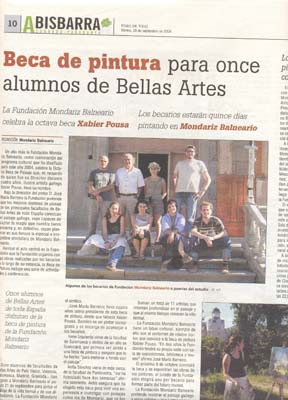My new hat
Bio
I was born near the sea, I studied a few years biology and completed my university studies in Fine Arts, thats how I link my two passions, art and nature. I consider myself a landscape painter of emotion, portraying the relationship between human beings and nature. Sometimes poetically, sometimes critical.
After living in Finland and Barcelona, I return to transmit everything I learned as an independent art teacher. My artistic career is still the engine, painting as an inseparable companion, and collaborative projects (such as Cova) that enrich the road even more.
Manifest
Intermediary between my soul and the world, I express it most of the time with art, painting happens to be like a comfort zone for me.
My goal is to be able to touch the souls, I want to leave images for emotion. I want to kidnap you from the apathy of the day for a few minutes.
The equation is between my imagination and my state of mind, so I create unique, contemporary work, sometimes critical, others poetical but always around how human beings are implicated with nature.
If I touch you, it touches me.
Texts
Painting as a place
“We don’t inherit the land from our ancestors; we
borrow it from our children” (Native American proverb)
There’s something that persists in painting: the creator’s look, the subject’s experience capable of creating and recreating something in the world that usually passes unnoticed. To Paul Klee it’s making the invisible visible, discovering the skeleton of things to Cezanne or a small sensation to Matisse.
Painting takes what’s native far away and then returns. Because it creates a place. It is a residence. Painting knows that nature is older, and something in her holistic condition survives in the work. From Claude Monet’s water lilies to the canoe in the water by Peter Doig. From the portraits of women and interiors with windows of Vanessa Bell to Tarsila do Amaral’s naive painting and tropicalism. From the almost hallucinatory flowers by Séraphine Louise to Georgia O’Keefe’s petals of blurred contours which lead to abstraction; a desert flower transformed into a landscape that opens like an eye, or a tornado. The surreal shades of Leonora Carrington and the conjugal trees of Max Ernst. Memoirs of a Nomad (1979) by Marie Marevna and the creatures flying over the roof of Chagall’s friend. Even in Maruja Mallo‘s The Ether Travelers and in Remedios Varo’s science fiction, the paint retains a strangeness. It’s an accomplice of secret interconnections. It’s a witness to the multiple relationships between all things. And it displays delicious variations of that sense of vitality.
The heterogeneous and eclectic work of Antía Sanchez (Vigo, 1975) includes works on paper, collages, drawings and oil paintings on various surfaces and objects such as palettes, trays or suitcases. It uses images from magazines and book illustrations from which shapes are cut and elements of memories extracted to be developed on the canvas in an attempt to arrest what one might stare at for a lifetime: the framed here and now. The work recovers the pictorial genre that Henry Rousseau—the customs officer—called portrait-landscape whose marginality offers balance represented by the integration of the human figure in the landscape as if it were its natural state over time.
The artist emerges in autobiographical work and paints the cyclical regeneration inherent in all matter, the continuous process of birth and death. Although faithful to change, some things recur; a symbolic repertoire that displays her personal universe, a persistent series of figures: the bird, the flower, women or the heart in an animal’s body. Guided by intuition she enters the landscape as if she entered a dream.
Vanesa Diaz. Art investigator
Naturaleza viva, Manuel Márquez Gallery, May 2011
Naturaleza viva is the tile of the exhibition of Antía Sánchez(Vigo, 1975)in which we can see her landscapes of the last year: view of the Cies islands from Cabo home, love flowers that emerge from among the rock or a couple at the shore of a lake in Poland.
Although she usually paints from life, in this series the pieces where mainly executed at her studio, from some excursions with the camera. A previous capture of the image at a certain time in a certain place, on the one hand, allows you to devote more time. Among the traces of landscape painters, Claude Monet, Friedrich or Peter Doig, she introduces the fantasy with unusual combinations of colors, a mystery that darkens the fields and condenses the mood of the environment, as if she painted from a branch, a rush or the trace of a cloud.
There is some kind of art that cannot be classified, previous to the classrooms and the teachers, and even to the sense. It is the case of Antía Sánchez, ´the painter of biology´ that tries to rescue universe wherever there is life with so many details until she dissolves in the painting, in what she is painting. Peaceful plains, blue heights under the daylight, windy days moving the leaves of the grass, animals buzzing in the evening. Kidnapped by the sensations, she talks to the Green vague outlines, for example in:
¡Y en su camisa hay flores! – De su pradera señora(1). The result are canvases breathing and producing a sudden seeing. She traps the patience of time on the canvas without losing its elusive nature.
We should look at her hands as the hands of a pianist to study where these recondite and splendid landscapes come from. Landscapes that are more subjective than the landscapes.
Vanesa Diaz.
(1)Lou Andreas Salome. El narcisismo como doble dirección. Tusquets. Barcelona, 1982. Pp 126.
Full CV
Contact
Antía Sánchez
Atelier: Rúa San Paio 138 Bajo
36212 Vigo
(+34) 654 831 086
antiasanchez@hotmail.com









